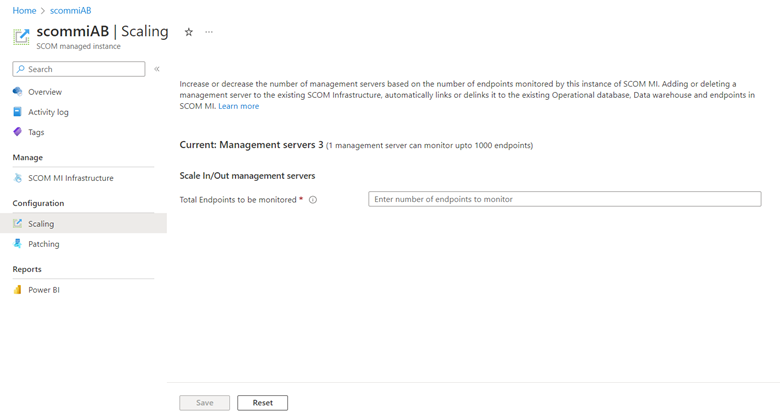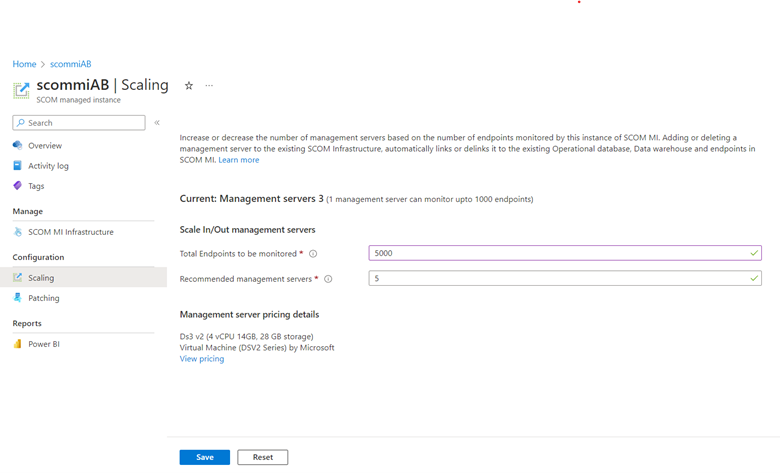Scale Azure Monitor SCOM Managed Instance
Addition or deletion of a management server to the existing System Center Operations Manager Infrastructure automatically links or delinks it from the existing Operational database, Data warehouse, and endpoints in SCOM Managed Instance.
This article provides information on how to scale your SCOM Managed Instance.
Pre-Scaling checklist
Before you proceed with the scaling process, complete the following prechecks to ensure a successful scaling operation:
SQL managed instance status: Verify that the SQL managed instance is operational and running, and not in a shutdown state.
Management server health: Confirm the health of the existing Management Servers.
Domain credentials verification: Validate the status of the domain credentials used in the key vault. If the credentials have expired, update the password to ensure they're active and functional.
NAT Gateway association: Ensure that the NAT Gateway is still associated with the subnet and hasn't been removed.
VNet connectivity requirements: Ensure that VNet to VNet communication is allowed to enable communication between the newly added managed servers and the existing ones. Additionally, verify that the connectivity from the VNet to the SQL managed instance and Domain Controller is operational.
Scale In/Out the management servers
To scale In/Out the management servers, follow these steps:
Sign in to the Azure portal and search for SCOM Managed Instance.
On the Overview page, under Configuration, select Scaling.

On the Scaling page,
- Current: Displays the existing number of management servers that are a part of the SCOM Managed Instance.
- Scale In/Out management servers:
Total Endpoints to be monitored: Enter the total number of endpoints you would like to monitor using a specific SCOM Managed Instance.
Recommended Management servers: Depending on the number of endpoints you enter, the ideal number of management servers to be provisioned will be recommended. You can change the recommended value as desired.
Note
A Management server can monitor up to 1000 endpoints.

Select Save to trigger the Scale In or Scale Out operation.
Troubleshoot scaling issues
Issue: In rare cases, after scaling, stale Management Servers are visible on console
Cause: Occurs if a scaling operation has left an inconsistent state after completion.
Resolution: Microsoft Azure Virtual Machine Scale Sets is used to provision the management servers for SCOM Managed Instances. To remove the stale management server from the system, follow these steps:
Access the Azure Virtual Machine Scale Sets and log in to one of the management servers for the SCOM Managed Instance.
Launch PowerShell in administrative mode and navigate to the following directory.
C:\Packages\Plugins\Microsoft.Azure.SCOMMIServer.ScomServerForWindows\<version>\bin\troubleshooterNote
To find the version, go to
C:\Packages\Plugins\Microsoft.Azure.SCOMMIServer.ScomServerForWindowsand review all available versions and then select the latest one.Execute the following script:
.\RemoveStaleManagementServers.ps1The script is interactive and prompts you for the FQDN of the stale server.
Provide the accurate FQDN of the stale management server you wish to remove.
For example, FQDN: SCOMMI2000001.contoso.com.
Next steps
Feedback
Coming soon: Throughout 2024 we will be phasing out GitHub Issues as the feedback mechanism for content and replacing it with a new feedback system. For more information see: https://aka.ms/ContentUserFeedback.
Submit and view feedback for